Christmas cactus, Schlumbergera spp., is one of the easiest houseplants to grow.
Not a desert cactus, but an epiphyte, it is one of a number of species and hybrids of rainforest plants that cling harmlessly to trees and rocks for support, drawing sustenance from the air, rainfall, and leaf litter in their immediate environment.
In our guide to growing Christmas cactus, we share insight on best practices for cultivation.
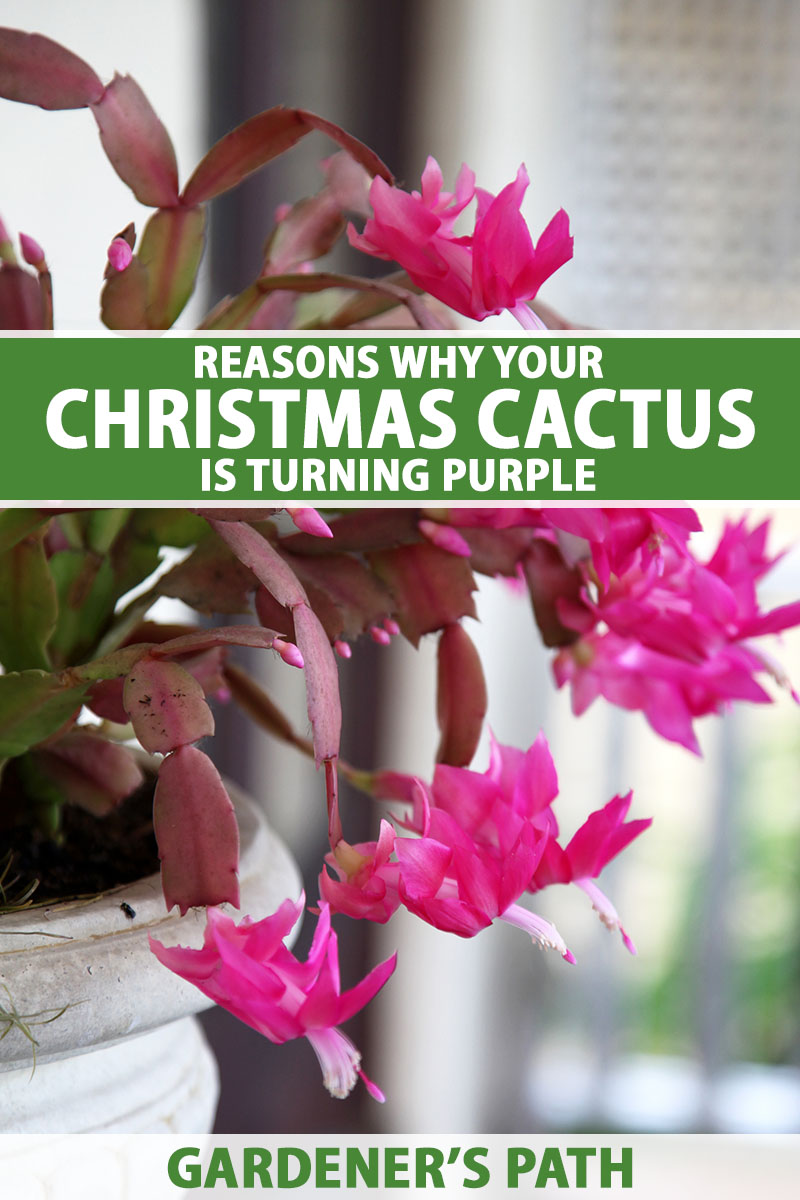
We link to vendors to help you find relevant products. If you buy from one of our links, we may earn a commission.
In this article, we talk about why the segmented green stems of a Christmas cactus sometimes turn purple.
Here’s what’s in store:
What You’ll Learn
Is Your Christmas Cactus Stressed?
Plants may not be able to speak, but they can still communicate with us, and let us know they are stressed.
One way a Christmas cactus lets us know it’s in trouble is by putting out thread-like aerial roots from between the stem segments.
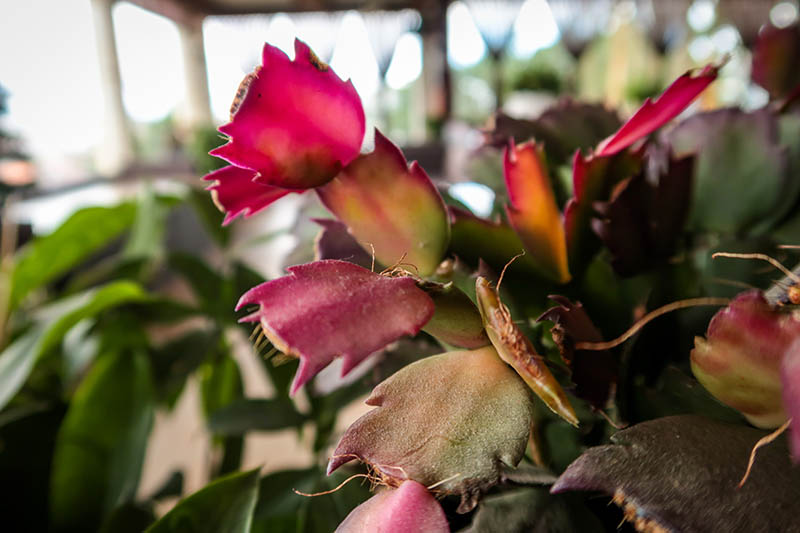
You can learn more about why Christmas cactus develops hair-like roots in our guide.
Another is for the stem segments to morph from their natural vibrant green to shades of purple, including red and pink, in response to stressful environmental conditions.
The four most likely reasons for purple-hued discoloration are: bright light, inappropriate moisture, nutrient deficiency, and extreme temperature fluctuations.
Let’s consider these stressors and how to avoid them.
Bright Light
A likely reason for purple coloration is exposure to bright, direct sunlight.
When a plant is genetically wired to grow in the sun-dappled shade of a rainforest canopy, an overabundance of light may trigger a protection response to the ultraviolet (UV) rays.
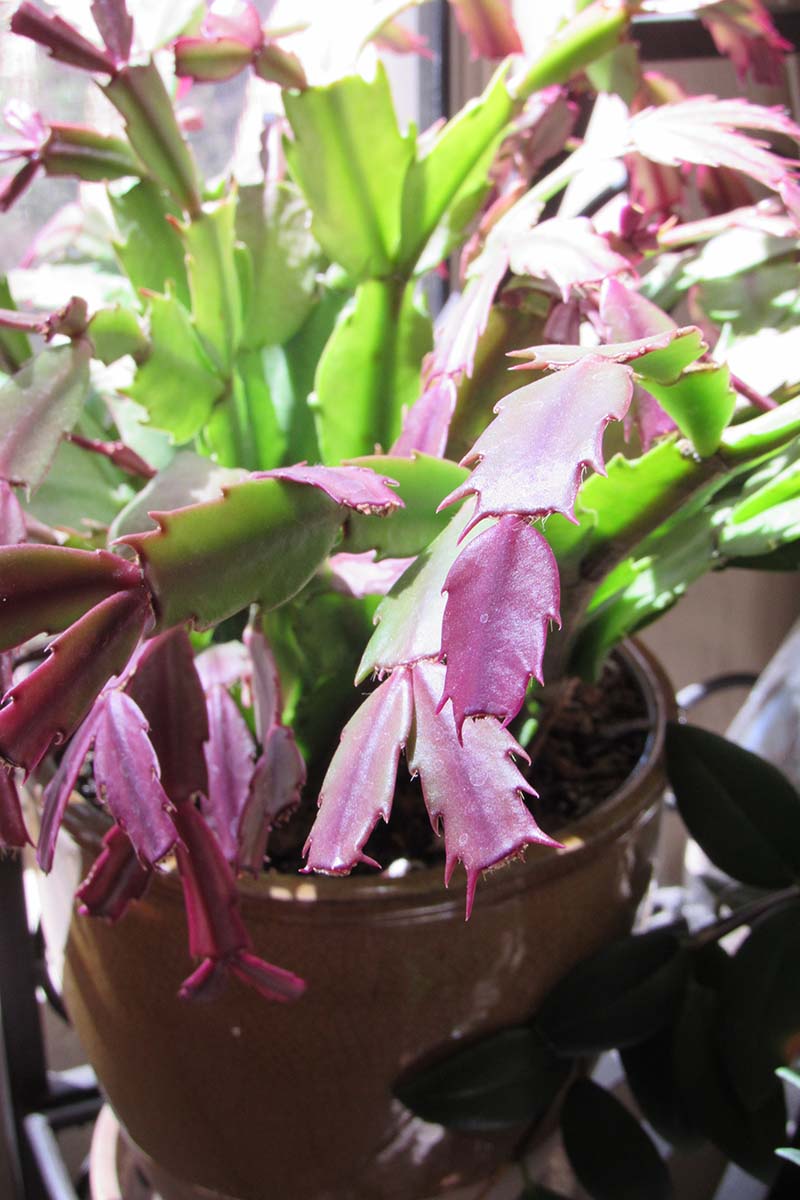
Instead of presenting with chlorophyll-rich green stems, the life-threatening bright light induces UV protective phenolic compounds called anthocyanins to dominate with their purple pigment.
A Schlumbergera that is left to contend with excessive sunlight will likely scorch, which can damage stem tissue beyond repair. This damage prevents it from absorbing sunlight, and jeopardizing photosynthesis, the conversion of sunlight to food.
Avoid this issue by choosing a location with indirect, or filtered sunlight, preferably facing north or west.
Inappropriate Moisture
Failing to accommodate the need for water may cause stress-induced color changes. Both under- and overwatering may be culprits.
Underwatering
An underwatered plant may turn purple before drying to a brittle, lifeless brown. Water is as essential as sunlight, and a lack of adequate moisture inhibits photosynthesis. Additionally, a very dry environment can cause the plant to become stressed.
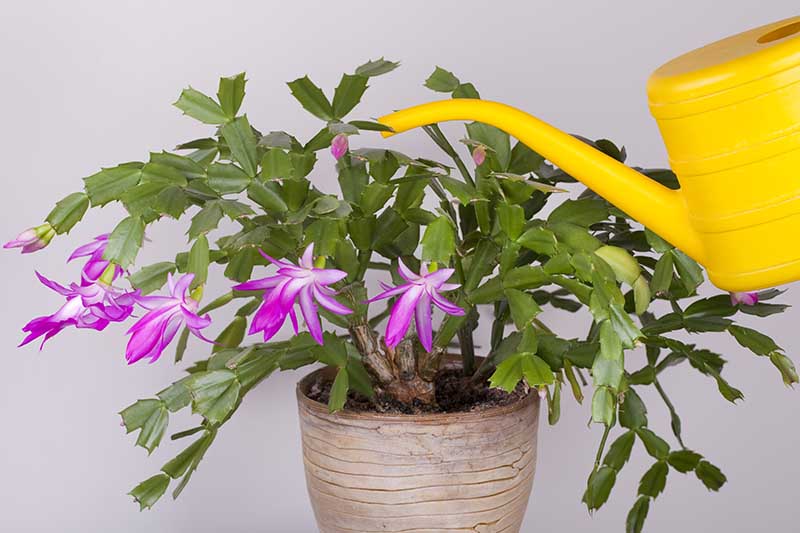
If you find that your home is dry during the winter, place a shallow pan of water in front of a heat register and sanitize it whenever it dries up. As the water evaporates, it adds moisture and humidity to the air.
Another evaporation method is to place your potted cactus on a bed of gravel in a shallow pan. Add enough water to cover the gravel.
You can also group houseplants together, and mist them occasionally to replicate the tropical moisture to which rainforest cacti are accustomed.
Overwatering
The flip side, overwatering, may cause leaves to yellow, and in extreme cases, take on a purple to brown cast before turning mushy. Severe over- or underwatering may extend all the way to the roots.
Air is another photosynthesis essential. When roots are waterlogged, they cannot breathe, posing a deadly challenge to the food production process.
To prevent moisture-related stress, use a pot with an ample drainage hole. Use a potting medium that is loose and well-draining.
Learn more about the right potting mix for your Christmas cactus in our guide.
Water only when the top one to two inches of potting medium feel dry.
If you’ve oversaturated your plant, you may be able to dry things out by digging the cactus up, rinsing its roots, cutting off any rotten patches, and repotting it in lightly moistened medium.
As a last resort, if the plant is severely damaged, you may be able to salvage at least a bit of stem segment or root that haven’t rotted, to propagate a whole new cactus.
Find more tips on saving an overwatered Christmas cactus here.
Nutrient Deficiency
And finally, your plant’s purple phase may be the result of a deficiency in one or more essential macronutrients, including magnesium, nitrogen, and phosphorus.
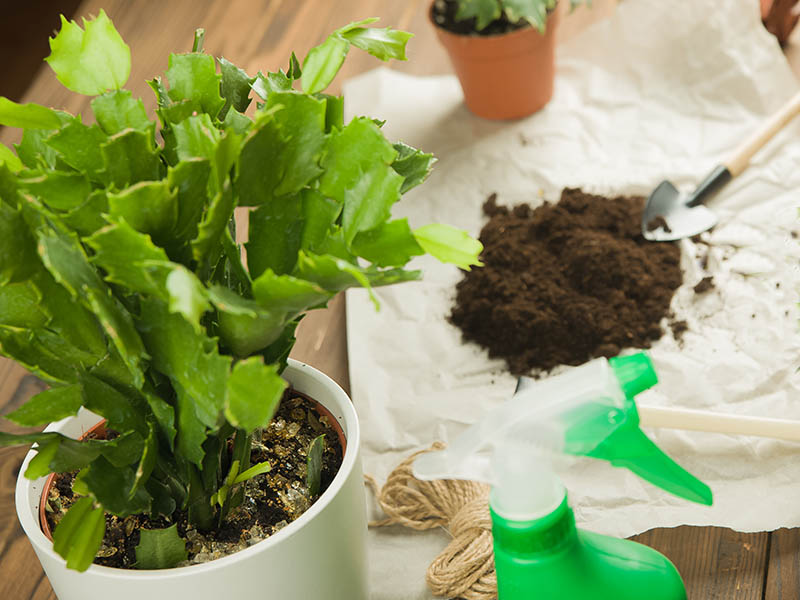
Malnutrition may occur because of:
- Poor quality potting medium from the start
- Nutritionally depleted potting medium due to years of use
- An extremely tight tangle of roots that can’t take up nutrients from the potting medium
- Root damage from transplanting, accidental damage, pests or disease, or improper watering
To remedy nutrient deficiencies, use a quality potting medium and repot as needed in a slightly larger pot, as Schlumbergera prefers a snug, but not densely rootbound fit.
Some folks apply a highly diluted Epsom salts solution (one teaspoon per gallon of water), but this presumes that the deficiency is magnesium.
You can give this a try, but if it doesn’t work, apply a well-balanced, slow-release all-purpose houseplant fertilizer to address all potential macronutrient deficiencies.
Learn more about fertilizing Christmas cactuses here.
Be sure to water properly, and watch for signs of insect infestation or growth anomalies that may suggest disease.
Temperature Extremes
The excessive heat associated with bright direct sunlight is a contributing factor to reactive discoloration, as a plant attempts to protect itself from the stressful climate condition.
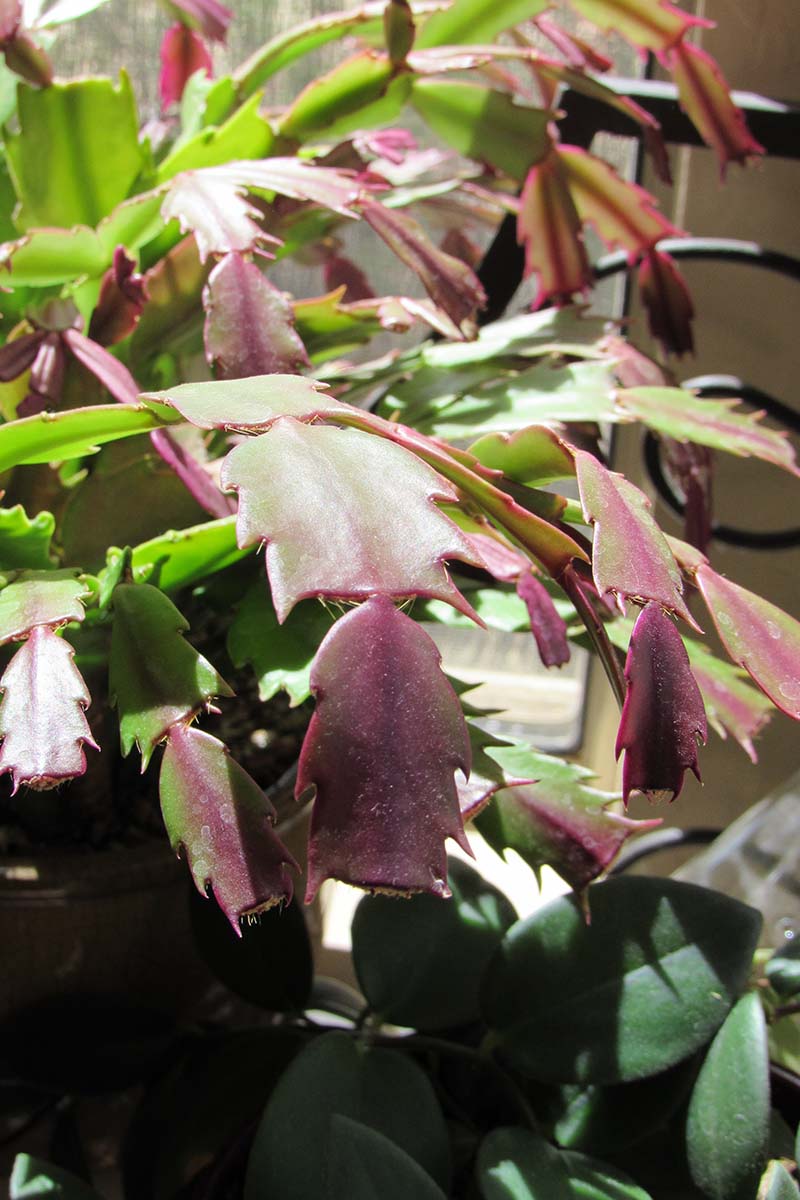
Similarly, cold temperatures may invite the same response, just like we see on outdoor perennials that have experienced chilling temperatures, but not a decimating frost.
To avoid temperature-induced discoloration, keep your cactus in a room with a temperature range of 70 to 80°F.
A short-term change in temperature is necessary during dormancy, to prepare a plant for blooming, which you can learn more about in our guide to encouraging your Christmas cactus to flower.
This requires six to eight weeks of 50 to 55°F temperatures, and long dark nights that mimic a natural winter.
Minimize temperature fluctuations by placing your pot in a location away from drafts from windows, heat registers, and exit doors.
I’m Talking to You
The best way to avoid triggering stress in your plant is with a consistent regimen of good horticultural care. Sometimes, however, conditions are less than ideal.
Shading to purple provides a visual cue that something is amiss. If you see this, examine your gardening practices and the indoor environment for the following:
- Light that is too intense.
- Too much or too little moisture.
- Depleted soil or extremely bound roots.
- Temperatures that overheat or chill.
Listen to your plant’s cry for help and act quickly.
Unless the effects of the stressors have progressed to desiccation or rotting, you can usually restore a cactus with a change of location and/or more vigilant care.
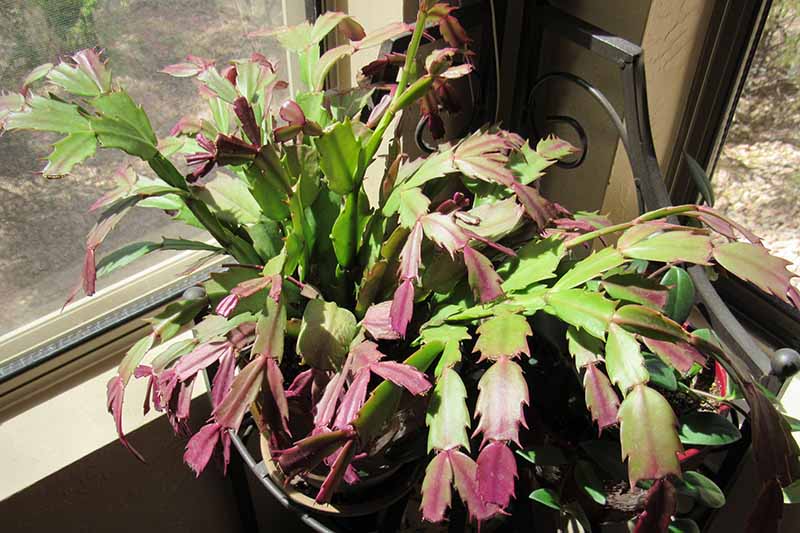
If it’s too far gone, you may be able to find a healthy bit of stem or root to snip off and use to propagate a whole new plant.
Cultivating Christmas cactus is easy when you “listen” and respond.
Has your Christmas cactus ever turned purple? Let us know in the comments below and share your tips!
If you found this article informative and want to expand your knowledge of Christmas cactus care, check out the following guides next:
© Ask the Experts, LLC. ALL RIGHTS RESERVED. See our TOS for more details. Uncredited photos: Shutterstock.
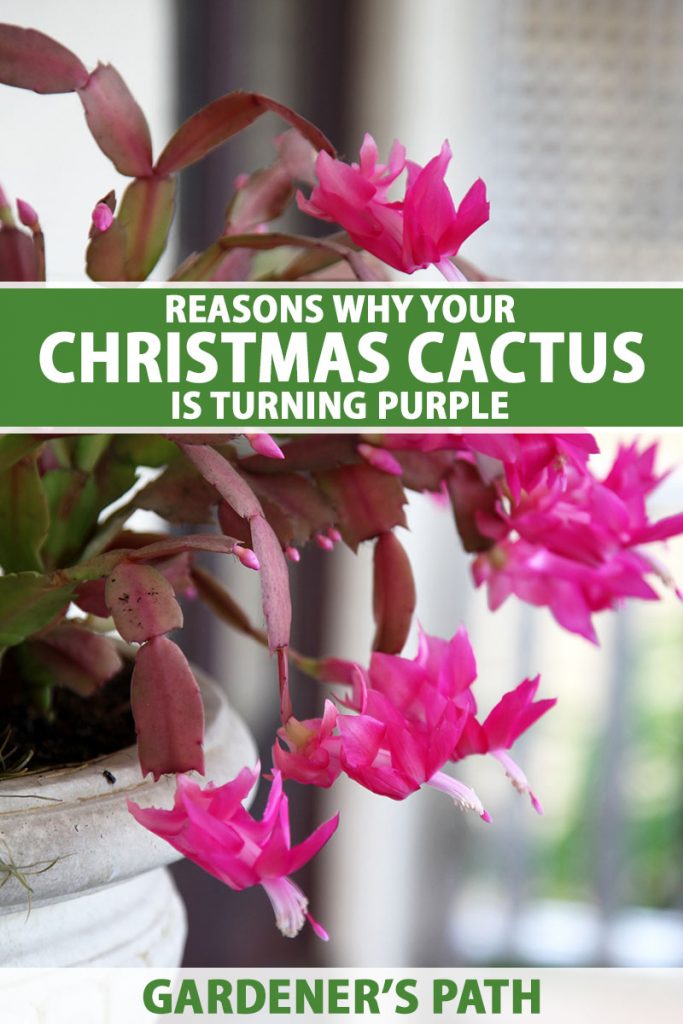

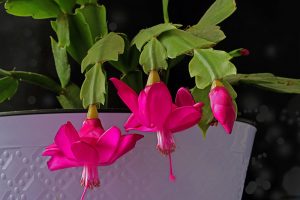

Thank you for the article Nan! In all my ignorance I thought for the longest time that the pinkness of my Schlumbergera was a sign of health! I now know it’s getting too much bright light. I will move it to a more optimal location right away, but should I let the pink parts of the stems be or should they be pruned?
Hi Hajer.
I like to leave plants alone as much as possible to avoid causing them stress. Use your best judgment, and avoid making major renovations to an otherwise healthy cactus.
Great Article! I thought the pink meant it was healthy and extra pretty. My Thanksgiving Cactus that is kept at work had a successful bloom this year and is actively growing new segments. But, the edges of the segments that grew in the last year all have the pink hue. It’s always been in a north facing window, but since spring hit we get a few hours of direct sun in the morning. I water it once a week. After reading your article I moved it away from the window into a more interior part of the building that gets… Read more »
Hello Amanda –
We’re so glad you enjoyed the article.
It sounds like you are giving your beloved plant the best of care. Recovery from overexposure and moving to a new location are indeed stressful. Unless the roots are working their way out of the bottom of the pot, and you can’t even find a spot to poke the spout of a watering can in, you can probably wait another year. This is a good time for a dose of liquid houseplant food diluted to half strength.
That’s a shame. I have a variegated Zygocactus as well so I thought the purple coloring was just another variety. It’s only a baby. It seems really healthy and is putting on new growth. The purple is so pretty, I’ll be sad when it goes all green.
I have pink/ purple leaves. I removed them. It is November 3. Will doing this keep my plants from blooming?
Hi Anne –
Yes, with a Christmas cactus the baby leaves shade to green as they mature. It sounds like yours is doing very well. That’s great!
Hi Alice –
Normally we prune post-bloom. I wouldn’t count on flowers this year, as the stress of overexposure and pruning will be followed by a recovery period. However, it’s not an impossibility.
Recently I purchased my first Christmas cactus. The very tips of the branches have what appears to be tiny leaves. I thought it was new growth, but since they are kind of purplish, and after reading your article, I was wondering if the poor thing is in distress. I have not transplanted it as of yet, since I wanted it to acclimate first.
Hi Barbara –
New growth at the tips has a pink/purple tint. It sounds like all is well.
I find it odd that this article is meant to be about Christmas cactus, yet every photo is of a thanksgiving cactus.
This seems quite misleading, and doesn’t give the article as much credibility as it potentially deserves- perhaps you could shed some light on this.
They are more or less the same thing. Christmas cactus vs thanksgiving cactus is more or less dependant on what the retailer wants to call it and are a bit interchangeable. These are trade names. Both refer to five or six species within Genus Schlumbergera and cultivars and hybrids of those species. Differences being mostly slightly different blooming times and pointy teeth vs rounded teeth on the leaves. You won’t find a “thanksgiving” cactus outside of the USA and Canada. Why? It’s a US and Canadian (different dates) centric holiday. Maybe the UK and associated Commonwealth of Nations should rename… Read more »
They are NOT the same thing. They are 2 different Species of plant, plain and simple..They come from from the same Genus as you say… Yes.. From these two groups you then get the cultivars ( where trade names occur) v The Truncata group and Buckleyi.group.. They are given Latin names to stop confusion.
The taxonomic classification of these plants is not settled and it’s almost impossible to find a true species plant for sale at your regular store.
After reading your info I have moved my cactus to a less bright location away from glass door on southern exposure and hopefully it will come back to green. Thanks so much it was helpful.
Hello Prem –
We’re glad the article has been informative and hope your plant fares well.
Have had my plant for at least 12 years. First time I’ve seen purple leaves. Is it possible to much fertilizer.
Hi Sue –
Provided it’s not a light or temperature issue, the most likely problem is that your plant is suffering from malnutrition. As a plant ages, it can become rootbound and unable to take up nutrients. It may be time for a new container that is one to two inches wider in diameter than the plant stems, as well as fresh potting medium. Give your freshly planted cactus a dose of half-strength liquid plant food once a month through the spring and summer. Suspend feeding from early fall until spring, and then resume.
This may be so in N Hemisphere. My Zygos live outside in bright sunlight, winds, over 40*C hot climate of Perth, Western Australia. I’ve grown these beautiful plants for 45years. Of 32 plants, only one receives less than full sun all year. It has the only purple-ish clades (below) but is first to flower of all my cool Schlumbergera. These harsh conditions are opposite their natural habitat but they thrive and produce masses of flowers. I keep 15 Hatiora (hot Schlumbergera) in 30% shade during winter and they join their cool Zygo cousins from Spring to Autumn. Try not to… Read more »
Hi Mysti –
Your plants are blooming beautifully and show the classic purple coloration caused by direct sunlight. Even though the leaves are purple, they still contain chlorophyll. The red and green or pink and green flower-leaf combinations that the plants have in their native habitat are pleasing to the eye and coordinate well with winter holiday schemes. Your excellent TLC regimen has done wonders to overcome the sun and heat stress.
Thank you, Nan ! I enjoyed the site and the comments. My Christmas cactus has grown very well over the past few years under a pink-toned grow light. It has been a great bloomer, going from Thanksgiving nearly to Easter, and even through spring has had a few blooms. Only lately the end leaves are turning purple. I wondered if it was the gro-light. Apparently there was too much of a good thing. The plants were growing closer to the light bulb. I would like to move them to a west facing window with indirect light from outdoors, but I… Read more »
Hello Patricia –
We’re glad you’ve discovered Gardener’s Path and are finding it informative.
A Christmas cactus likes bright indirect sunlight. An LED grow light may alter the leaf color, especially without at least 24 inches between the light and the soil surface.
Increase the distance between your plant and grow light as needed.
Now is a good time to feed your cactus with a 50 percent dilution of liquid houseplant food.
And if you decide to move it to the west window, wait until fall dormancy.